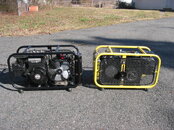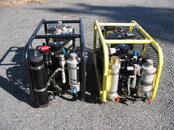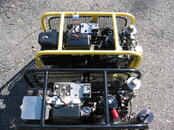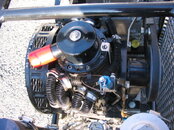This post is for technoids so if you don't swing that way now is the time to tune out. Away we go.
I guess I'll never know the details of how these Kidde units were made. We're talking the mid 1950's time frame when technology was not so advanced. However, some really remarkable achievements were made back in those days leading to space travel, etc. The military, in particular, used a cost-no-object approach to obtain certain components and systems which met their requirements. For example, every effort was made to keep the weight of aircraft components as light as possible. A weight saving of a few ounces could be regarded as justifing a merit award to that individual or contractor. Vibration is another area of concern. Therefore, a lighter, onboard compressor with zero vibration was a goal.
The Kidde compressor began life in 1951 as a component of the F-86 jet fighter. It saw much action in the Korean war serving up high pressure should in flight engine starting be required. It probably saved more than a couple lives in the process. By 1958, a new design of this compressor emerged which was even lighter than the first model. The block was shortened and the orientation and location of the cylinders was changed. Instead of the second stage being located on bottom this position was now occupied by the fourth stage. The cylinders were now set at right angles and used screw in barrels instead of bolt on. The heads of the new design were bolted on as opposed to the old screw on heads. It was a true radial design.
After Kidde was acquired by a British company this tradition continued while manufacturing was carried out to some extent "offshore". Kidde compressors made in the 60's carried the appellation "Rotax type" meaning the Compressor originated with this Austrian company. Regardless of who made what, the quality of construction is what intrigues me.
I have a lathe and can use some basic tools but in no way whould I attempt to make something to fit one of these compressors. The materials are one impediment. The pistons (3rd and 4th plungers) and valve heads (valve seats) are made from heat treated inconel which is one of the hardest metals that I have seen. The pistons are mirror polished and (as best I can determine) accurate to 0.0001 inch. I don't even know how to make a consistant measurement like that because heat from the human hand will change the micrometer reading by more than that. Moreover, my lathe has more wobble than that so I couldn't machine it in the first place. In the "factory" the Kidde was assembled by one person using parts with accuracies approximately as I've described. After machining and heat treatment the pistons and barrels were hand fitted. In other words, parts which were made to the maximum accuracy possible were than mixed and matched until a perfect fit of piston and barrel were found. (IMO, the accuracy in machining of the parts of the second generation compressor makes it a breeze to set valve and head clearance. When installing a new stage about the only really crucial measurement is that of the height of the piston and then the rest takes care of itself).When the unit was nearly complete it was mounted to a motor and run for many hours with several oil changes along the way. This is called "running in". During the run in period several performance factors were monitored including something called blow by which is the amount of gas bypassing the pistons and entering the crankcase. Typically, a commercially made compressor will have considerable blowby. Bauer allows up to 0.35-0.7 cfm. By comparison, my two Kidde pumps have no measurable blowby, none. Kidde states that anything up to 0.3 cfm is acceptable but I can tell from personal experience that is a high level and an indication of many, many hours of hard running. Blowby measurements of a pump that had more than 2500 hours of running gave 0.5 cfm. I say it was worn out but that is relative. Replacement of the fourth stage cut that number in half and the compressor had excellent pump up time. Everything else worked.
Later, I'll talk about some other design features and one or more commonly encountered problems.








